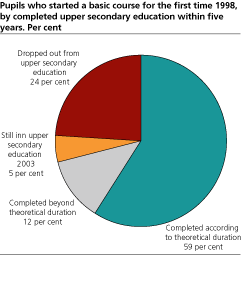Content
Published:
This is an archived release.
Girls most likely to complete education
65 per cent of the girls who enrolled on a basic course for the first time in 1988 completed the course in time, whereas 76 per cent completed within five years. The corresponding figures for boys were 10 percentage points lower for both groups.
The differences between boys and girls are evident in both general studies and vocational studies. Furthermore, girls with immigrant background do better than their male counterparts. Compared to previous results, there has been a general reduction in drop out rates among immigrant pupils.
Children of parents with higher education more likely to complete education
Parents' educational background affects throughput rates of pupils in upper secondary education. As many as nine out of ten pupils who started a basic course for the first time in 1998 and had parents with a long tertiary education, completed upper secondary education within five years. In comparison, two out of three pupils whose parents had upper secondary education and less than half of those whose parents had primary or lower secondary education completed the education within five years.
Tables:
- Table 1 Pupils who started a basic course for the first time in 1994, 1997 and 1998, by completed upper secondary education within five years and by gender. Per cent
- Table 2 Pupils who started a basic course for the first time in 1994 and 1997, by completed upper secondary education within five years, areas of study and gender. Per cent
- Table 3 Pupils who started a basic course for the first time in 1997 and 1998, by completed upper secondary education within five years, gender and parents' level of education. Per cent
- Table 4 Pupils and who started a basic course for the first time in 1997 and 1998, by completed upper secondary education within five years, gender and county of residence at 16 years of age. Per cent
- Table 5 Immigrants who started a basic course for the first time in 1997 and 1998, by completed upper secondary education within five years, gender and country background. Per cent
Additional information
Statistics follow an intake of pupils through a five-year period in upper secondary education.

